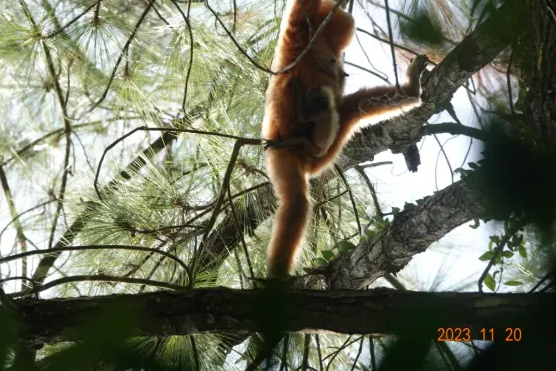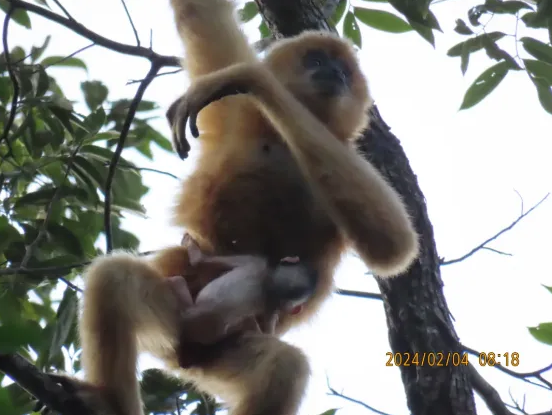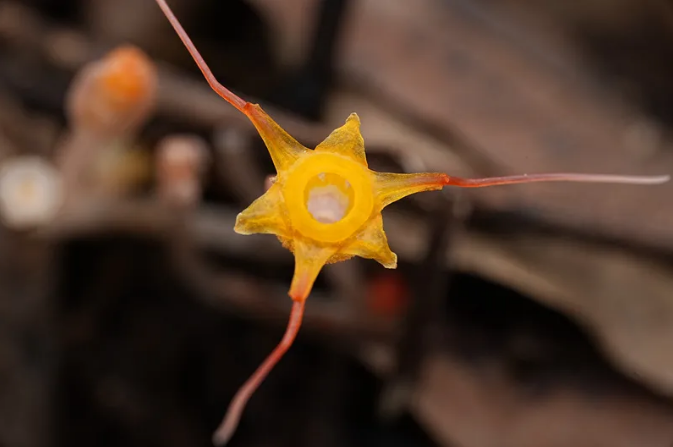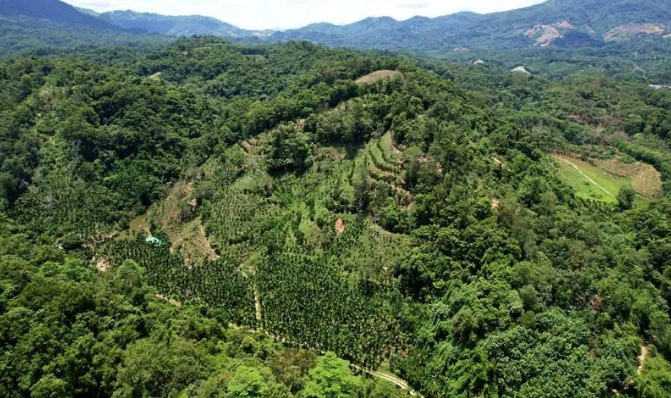Hainan develops as a National Ecological Civilization Pilot Zone

The excellent ecological environment is Hainan's strongest advantage and greatest asset. Recently, Hainan has worked to reduce carbon and pollution, expand the use of green technologies and growth strategies, and accelerate green, low-carbon development, working to develop as a national ecological civilization development zone.
Protecting the Beauty of Biodiversity
In June, China's National Forestry and Grassland Administration announced that the population of Hainan Gibbons had increased from a low of ten individuals living in two family groups forty years ago to the current 42 individuals living in seven family groups. Since Oct., 2022, five precious new gibbons were born, and a new family group was formed.

The baby gibbon born to Troop C in November 2023. Photo provided by the Bawangling Ridge Section of the Hainan Tropical Rainforest National Park

A new baby was born to Troop G in Feburary of this year. Photo provided by the Bawangling Ridge Section of the Hainan Tropical Rainforest National Park.
New species are constantly being discovered in Hainan's rainforests! Recently, four new mushrooms in the Suillus genus, as well as Thismia tentaculata, a delicate flower with extremely high environmental and climate requirements, were observed for the first time in Hainan. A forest ranger also took the first photo of the Pale-capped Pigeon in the wilds of the Hainan Fanjia Provincial Nature Reserve.

Photo shows Thismia tentaculata K. Larsen & Aver., a newly recorded plant species, in the Wuzhishan section of the Hainan Tropical Rainforest National Park in south China's Hainan Province. (Photo by Wu Wanli, People's Daily)
Hainan accounts for around 19% of China’s total number of wild vascular plant species, as well as 31% of birds, 19% of mammals, 7% of amphibians, and 22% of reptiles. There are 2,321 species of fish and over 3,100 species of medicinal value here, and all of China's mangrove species can be found flourishing in the province.
From tropical rainforests to mangroves, and from coral reefs to seagrass beds, Hainan is incredibly biodiverse, containing a multitude of ecosystems including forests, wetlands, oceans, and islands, and making this a key global biodiversity conservation hotspot. “It's breathtaking!” Hainan's incredibly rich biodiversity made David Cooper, Acting Executive Secretary of the Secretariat of the Convention on Biological Diversity, exclaim in amazement.
How can Hainan's biodiversity be protected? Hainan continues to take new steps to preserve this rich heritage.
Hainan's biodiversity protection legal and policy systems are continuing to improve. Over 40 protection measures, including the Hainan Nature Reserve Regulations and the Hainan Tropical Rainforest National Park Regulations (Trial), have been formulated and revised, developing a relatively complete biodiversity protection legal and policy system. China has now published its first provincial biodiversity conservation strategy and action plan.
Hainan continues to optimize in situ and ex situ biodiversity conservation. A large nature reserve system has been established in Hainan, with the Hainan Tropical Rainforest National Park forming the main part of the reserve. A total of 78 nature reserves were included in this endeavor, covering a total land area of 575,500 hectares and accounting for 17% of the province's total land.
Ecosystem restoration is making steady progress. The integrated ecological protection and restoration of Hainan's mountains, rivers, forests, farmlands, lakes and grasslands is being strengthened, and in-depth projects such as coastline improvement and restoration, ecological restoration of river and lake ecological buffer zones, wetland restoration, soil erosion control, and ecological restoration of abandoned mines are underway, improving the habitats of wild animals and plants in key areas of the island. Protection of Hainan's forest regions remains a high priority, and continues to expand.
According to Huang Runqiu, Minister of the Ministry of Ecology and Environment, Hainan is a microcosm and model of China's biodiversity conservation, and provides an excellent example for international tropical rainforest biodiversity conservation projects to follow.
Landmark projects are being accelerated
Haikou resident Wu Meixian placed items into her own environmentally friendly cloth bag as she checked out at a Haikou supermarket. “I can protect the environment and save money too!” In Hainan supermarkets, many shoppers have gotten into the habit of bringing their own reusable shopping bags.
As one of the landmark projects in Hainan's national ecological civilization pilot zone development, Hainan has carried out a comprehensive plastic ban in recent years, with plastic substitutes achieving an over 80% usage rate in nine key industries. Hainan's government canteens, sanitation systems, public hospitals, schools, and other facilities have basically stopped using disposable non-degradable plastic products. Meanwhile, all fifty-five of Hainan's 3A rated and above scenic attractions have also achieved a comprehensive plastic ban, with over 90% of locals showing basic awareness of Hainan's plastic bans.
What is the meaning of ecological civilization development? Reducing plastic pollution is not the only solution.
Hainan's six landmark projects form an excellent starting point, and the Free Trade Port's policy, resource, and location advantages all continue to boost the development of the province as a national ecological civilization pilot zone.
The overall plan of the Hainan Tropical Rainforest National Park was announced and implemented, and was the first nationally to complete the registration and issuance of certificates for natural resource rights and GEP (Gross Ecosystem Project) accounting. The population of the critically endangered Hainan Gibbon continues to grow, and steady progress is being made in the development of Hainan's national park.

Photo shows a view of the Wuzhishan section of the Hainan Tropical Rainforest National Park in south China's Hainan Province. (Photo by Meng Fansheng, People's Daily)
On average, one of every two cars sold in Hainan is a new energy vehicle. Last year, over 50% of new vehicles registered in the province were new energy vehicles, the highest rate in the nation, while Hainan ranked second nationally in terms of total NEV ownership. Clean energy power installations now cover 78.5% of the province.
Pre-fab building construction in Hainan is also on the rise, with new pre-fab construction projects accounting for over 70% of all new construction in 2023, and estimates show that this year the number will rise to over 75%.
Six projects involving sewage treatment, water supply guarantees, water drainage, flood prevention, water conservation, and seawater improvement have been coordinated and moved forward, while all 19 of Hainan's polluted bodies of water were treated. The ecological environment of the province's rivers and lakes continues to improve.
The 18 engineering projects in eight categories in the Boao Near-Zero Carbon Demonstration Zone have been completed, achieving a reduction of approximately 11,000 tons of carbon dioxide equivalent by 2023 and becoming a national and global forerunner.
From the heights of the mountains to the depths of the sea, and from the teeming cities to the wide-open vistas of the countryside, one landmark project after another has blazed a trail, leading the green development of Hainan in key areas such as energy, construction, and transportation, while also pushing forward the rapid development of emerging industries such as wind power equipment manufacturing, prefabricated buildings, and fully biodegradable plastics. Hainan's economic development is growing ever greener, and the Free Trade Port is putting down strong, deep, green roots in the rich soil of the province.

Office of the Hainan Free Trade Port Working CommitteeNo. 69 Guoxing Avenue, Meilan District, Haikou City, Hainan Province, 570203, China

hnshgb_xchch@sina.com
Contact Us
- Latest News
- Video News
- Specials
- Press Release
- Upcoming Events
What's New in Hainan
- Industrial Park
- Tax
- Trade
- Investment
- Entry & Exit
- Finance
Invest in Hainan
- Weather
- Transportation
- Health Care
- Attractions & Food
- Fitness & Sports
- Arts & Culture
Live in Hainan
- Copyright © 2020 Hainan Free Trade Port
- Qiong ICP 19005356
- All Rights Reserved





